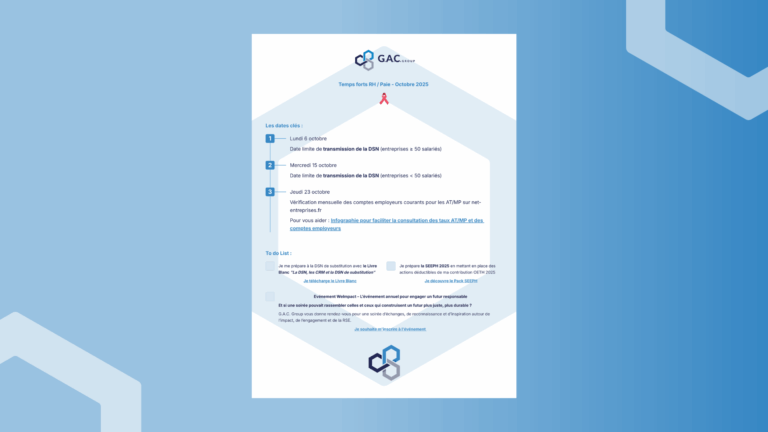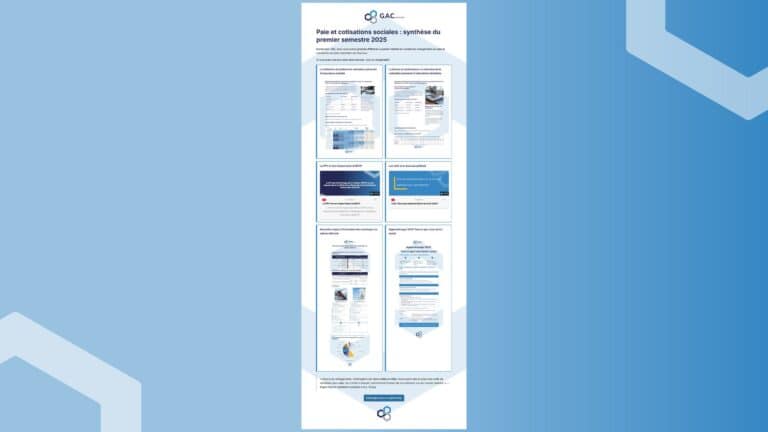The decree no. 2025-318 of April 4, 2025published in the Official Journal on April 6, 2025, stipulates that ". By derogation from the first sentence of the third paragraph of thearticle D. 242-6-11 of the Social Security CodeFor the year 2025, the tariffs mentioned in this paragraph come into force on May 1, 2025".
So, in line with the ameli.fr websiteFor the year 2025, the AT 2024 rates remain applicable until April 30, 2025. The 2025 occupational injury contribution rates will apply from May 1, 2025, without retroactive effect.
To help you anticipate this period of notification of the new AT/MP rates, our experts suggest a review of the elements that make up the AT/MP rate and the key points to check.
Notification of the accident/illness rate
Since January 1, 2024, dematerialized notification of occupational injury contribution rates has been compulsory for all companies covered by the general scheme.
Companies will be able to consult their 2025 rates online, in their company account, once the decrees setting increases, collective rates and average costs have been published.
As a reminder, companies have 2 months from notification of the rates to contest their validity.
Determining the accident/illness rate
The AT contribution rate is determined according to :
- of your company's total workforce,
- of your activity (risk code),
- and your claims experience (occupational injuries and diseases covered by occupational legislation).
This rate is specific to each establishment in your company.
Total number of employees
The company workforce is the average of the number of people employed during each month of the calendar year. It is national, calculated monthly and takes into account the actual working periods of each employee. At 1
The workforce to be taken into account is that of year N-2.
Three pricing methods exist depending on the size of the company:
- From 1 to 19 employees: Your contribution rate is set each year by Ministerial Order published in the Journal Officiel. This contribution rate depends on the risk code assigned to you. It is specific to each section of your establishments, depending on the activity carried out by the majority of employees.
- From 20 to 149 employees: Your rate is called "mixed". The rate is calculated by taking into account a fraction of the collective rate for the activity and a fraction of the value of the risk, which corresponds to the sum of the average costs of occupational injuries covered under professional legislation.
- From 150 employees: Your rate is called "individual" or "real". The company bears the actual cost of each claim.
Special features in the building and civil engineering sector and in Alsace-Moselle:
In the construction sector (except Alsace Moselle) companies contribute at a specific rate, the “single BTP” rate. Consequently, all of the sites, depots, workshops, administrative entities, etc. falling under the same risk code constitutes an establishment and each is subject to the same contribution rate.
In Alsace Moselle, including for the construction industry, the thresholds differ but the calculation methods remain identical. First of all, collective pricing is applicable to companies with less than 50 employees or for establishments created less than three years ago or for establishments falling within the activities referred to in Article D. 242-6-14 of the Code of social Security. Then, individual pricing is applicable to companies with more than 149 employees and mixed pricing is applicable to companies with 50 to 149 employees. Finally, for companies in the construction industry, pricing becomes individual from 300 employees.
Activity and average costs
The average costs correspond to the average expenditure caused by claims of equivalent severity for each of the national technical committees (CTN).
These average costs are calculated at national level, by major activity sector (CTN) and under the control of the
social partner members of the Commission des AT/MP.
There are two categories of average cost (CCM):
- First of all, the categories of average costs for claims with temporary incapacity which determine the value of the risk linked to the care and daily allowances for each recognized work accident or occupational disease (number of days of prescribed work stoppages)
- Then the categories of average costs for claims with permanent disability. They determine the value of the risk associated with permanent disability or death.
The company's claims experience
Finally, the rates of occupational injury and disease are calculated on the basis of the occupational injuries and diseases that have occurred within the company and appear in the employer's accounts.
Some errors may occur, and checks can be carried out. Here are just a few of the checks you can carry out (non-exhaustive list):
- Check that no commuting accident does not appear on your employer's statement of account and affect your AT rate,
- Check that the claims referenced are charged with the correct number of days off work,
- Verify that claims that have been the subject of a refusal to take do not appear on your employer's account statements,
- Check that the average associated costs are those applicable to claims.
In conclusion, you've understood how important it is to master the elements that make up the AT/MP rate. A good understanding of it will lead to relevant and effective management!








